Think Better
- Posted February 5, 2018
- By Bari Walsh and Iman Rastegari
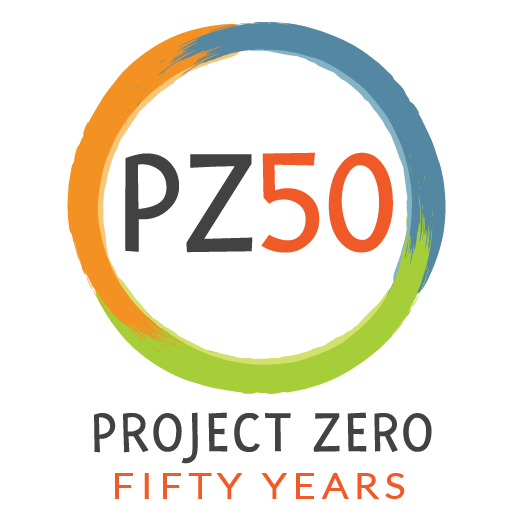
Part of a yearlong series exploring Project Zero’s 50 years of innovation in education.
What does it mean to think well?
Over the span of five decades, researchers at Project Zero have probed the question, concluding that the act of thinking well is not just about mastering a cognitive skill. It’s also, in equal parts, about developing a disposition — a mindset that combines capacity with readiness, motivation, and an alertness to the opportunity to use our skills.
Thinking is a necessary precursor to learning, the researchers say, so the idea is not just to think; it’s to think when it counts — to take advantage of opportunities to use the thinking skills we have, to notice the times when they might be useful, and to activate your learning.
Routines like See, Think, Wonder might seem almost too simple — but they were designed that way, to be easy to remember and use. The intention is not to simplify ideas; it’s to simplify the ways to approach and engage with ideas, and make a habit of that process.
So, can “good thinking” be taught? Project Zero research suggests that it can.
Building on insights developed by David Perkins , Ron Ritchart , and Shari Tishman , Project Zero has created a large suite of “ thinking routines ” — exercises, activities, discussion prompts, and practices — that help students develop habits of mind that support good thinking in a variety of situations and contexts. (For example, the video below illustrates a routine called +1 , part of a collection of tools in Pathways to Understanding , which Project Zero designed to develop note-taking and memory skills.)

Thinking Well, When It Counts
According to Project Zero's approach, the habits of mind that foster good thinking include:
- Having a repertoire of thinking moves to draw on;
- Having an inclination to use those moves;
- Being sensitive to the times when thinking would be helpful.
Good thinkers are in the habit of observing, analyzing, and questioning , Project Zero researchers have theorized. Thinking routines — a set of short questions or a sequence of steps — build those habits by:
- Helping students become close observers, go beyond the superficial, and dig deep;
- Teaching them to organize their ideas;
- Giving them tools to navigate complexity;
- Prompting them to reason carefully;
- Prompting them to reflect on how they’re making sense of things.
Thinking routines are simple structures, designed to be practical, easy to remember, and easily transferrable across subjects or disciplines. A classic example is See, Think, Wonder .
- What do you see ?
- What do you think about that?
- What does it make you wonder ?
When used repeatedly and intentionally, this exquisitely simple routine can encourage close analysis and thoughtful interpretation — and it can become a habitual part of the way students approach a new topic or idea. It stimulates their curiosity and provides a path forward.
There are many other routines to sample , but just as most habits develop from repetition, PZ researchers say that habits of mind do, too. They suggest that practitioners who are new to the technique choose one core thinking routine and try it out in as many contexts as possible . Once they’re comfortable with the way that one thinking routine has worked in their classroom, they can branch out and focus on different kinds of inquiry, like Here Now/There Then , which could be used in a civics class to help students understand how past perspectives change over time; or Parts, Purpose, Complexities , which encourages observation and understanding of art objects or mechanical systems.
Routines like See, Think, Wonder might seem almost too simple — but they were designed that way, to be easy to remember and use. The intention is not to simplify ideas; it’s to simplify the ways to approach and engage with ideas . By breaking down the thinking process and by making thinking visible , thinking routines foster a community of thinkers in a classroom and a culture of thinking in a school or district.
Additional Resources
- Project Zero's research on cognition, thinking, and understanding
- Visible Thinking, an online course for educators
- More on Visible Thinking from Project Zero

Usable Knowledge
Connecting education research to practice — with timely insights for educators, families, and communities
Related Articles
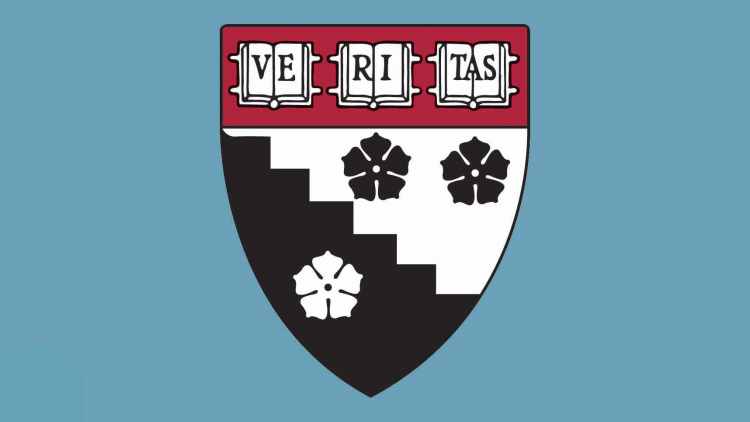
Part of the Conversation: Rachel Hanebutt, MBE'16
Fighting for change: estefania rodriguez, l&t'16, notes from ferguson.
Our websites may use cookies to personalize and enhance your experience. By continuing without changing your cookie settings, you agree to this collection. For more information, please see our University Websites Privacy Notice .
Center for Excellence in Teaching and Learning
- Critical Thinking and other Higher-Order Thinking Skills
Critical thinking is a higher-order thinking skill. Higher-order thinking skills go beyond basic observation of facts and memorization. They are what we are talking about when we want our students to be evaluative, creative and innovative.
When most people think of critical thinking, they think that their words (or the words of others) are supposed to get “criticized” and torn apart in argument, when in fact all it means is that they are criteria-based. These criteria require that we distinguish fact from fiction; synthesize and evaluate information; and clearly communicate, solve problems and discover truths.
Why is Critical Thinking important in teaching?
According to Paul and Elder (2007), “Much of our thinking, left to itself, is biased, distorted, partial, uninformed or down-right prejudiced. Yet the quality of our life and that of which we produce, make, or build depends precisely on the quality of our thought.” Critical thinking is therefore the foundation of a strong education.
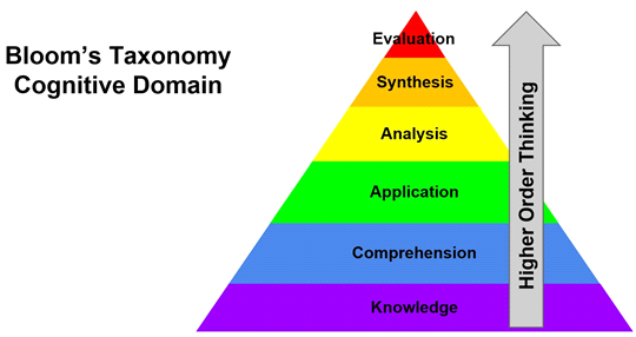
Using Bloom’s Taxonomy of thinking skills, the goal is to move students from lower- to higher-order thinking:
- from knowledge (information gathering) to comprehension (confirming)
- from application (making use of knowledge) to analysis (taking information apart)
- from evaluation (judging the outcome) to synthesis (putting information together) and creative generation
This provides students with the skills and motivation to become innovative producers of goods, services, and ideas. This does not have to be a linear process but can move back and forth, and skip steps.
How do I incorporate critical thinking into my course?
The place to begin, and most obvious space to embed critical thinking in a syllabus, is with student-learning objectives/outcomes. A well-designed course aligns everything else—all the activities, assignments, and assessments—with those core learning outcomes.
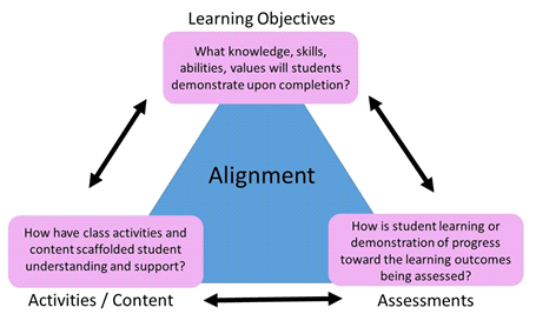
Learning outcomes contain an action (verb) and an object (noun), and often start with, “Student’s will....” Bloom’s taxonomy can help you to choose appropriate verbs to clearly state what you want students to exit the course doing, and at what level.
- Students will define the principle components of the water cycle. (This is an example of a lower-order thinking skill.)
- Students will evaluate how increased/decreased global temperatures will affect the components of the water cycle. (This is an example of a higher-order thinking skill.)
Both of the above examples are about the water cycle and both require the foundational knowledge that form the “facts” of what makes up the water cycle, but the second objective goes beyond facts to an actual understanding, application and evaluation of the water cycle.
Using a tool such as Bloom’s Taxonomy to set learning outcomes helps to prevent vague, non-evaluative expectations. It forces us to think about what we mean when we say, “Students will learn…” What is learning; how do we know they are learning?
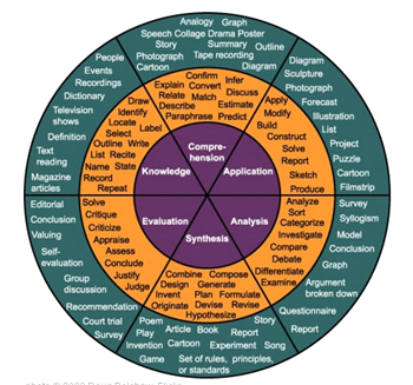
The Best Resources For Helping Teachers Use Bloom’s Taxonomy In The Classroom by Larry Ferlazzo
Consider designing class activities, assignments, and assessments—as well as student-learning outcomes—using Bloom’s Taxonomy as a guide.
The Socratic style of questioning encourages critical thinking. Socratic questioning “is systematic method of disciplined questioning that can be used to explore complex ideas, to get to the truth of things, to open up issues and problems, to uncover assumptions, to analyze concepts, to distinguish what we know from what we don’t know, and to follow out logical implications of thought” (Paul and Elder 2007).
Socratic questioning is most frequently employed in the form of scheduled discussions about assigned material, but it can be used on a daily basis by incorporating the questioning process into your daily interactions with students.
In teaching, Paul and Elder (2007) give at least two fundamental purposes to Socratic questioning:
- To deeply explore student thinking, helping students begin to distinguish what they do and do not know or understand, and to develop intellectual humility in the process
- To foster students’ abilities to ask probing questions, helping students acquire the powerful tools of dialog, so that they can use these tools in everyday life (in questioning themselves and others)
How do I assess the development of critical thinking in my students?
If the course is carefully designed around student-learning outcomes, and some of those outcomes have a strong critical-thinking component, then final assessment of your students’ success at achieving the outcomes will be evidence of their ability to think critically. Thus, a multiple-choice exam might suffice to assess lower-order levels of “knowing,” while a project or demonstration might be required to evaluate synthesis of knowledge or creation of new understanding.
Critical thinking is not an “add on,” but an integral part of a course.
- Make critical thinking deliberate and intentional in your courses—have it in mind as you design or redesign all facets of the course
- Many students are unfamiliar with this approach and are more comfortable with a simple quest for correct answers, so take some class time to talk with students about the need to think critically and creatively in your course; identify what critical thinking entail, what it looks like, and how it will be assessed.
Additional Resources
- Barell, John. Teaching for Thoughtfulness: Classroom Strategies to Enhance Intellectual Development . Longman, 1991.
- Brookfield, Stephen D. Teaching for Critical Thinking: Tools and Techniques to Help Students Question Their Assumptions . Jossey-Bass, 2012.
- Elder, Linda and Richard Paul. 30 Days to Better Thinking and Better Living through Critical Thinking . FT Press, 2012.
- Fasko, Jr., Daniel, ed. Critical Thinking and Reasoning: Current Research, Theory, and Practice . Hampton Press, 2003.
- Fisher, Alec. Critical Thinking: An Introduction . Cambridge University Press, 2011.
- Paul, Richard and Linda Elder. Critical Thinking: Learn the Tools the Best Thinkers Use . Pearson Prentice Hall, 2006.
- Faculty Focus article, A Syllabus Tip: Embed Big Questions
- The Critical Thinking Community
- The Critical Thinking Community’s The Thinker’s Guides Series and The Art of Socratic Questioning

Quick Links
- Developing Learning Objectives
- Creating Your Syllabus
- Active Learning
- Service Learning
- Case Based Learning
- Group and Team Based Learning
- Integrating Technology in the Classroom
- Effective PowerPoint Design
- Hybrid and Hybrid Limited Course Design
- Online Course Design
Consult with our CETL Professionals
Consultation services are available to all UConn faculty at all campuses at no charge.
Classroom Q&A
With larry ferlazzo.
In this EdWeek blog, an experiment in knowledge-gathering, Ferlazzo will address readers’ questions on classroom management, ELL instruction, lesson planning, and other issues facing teachers. Send your questions to [email protected]. Read more from this blog.
Eight Instructional Strategies for Promoting Critical Thinking

- Share article
(This is the first post in a three-part series.)
The new question-of-the-week is:
What is critical thinking and how can we integrate it into the classroom?
This three-part series will explore what critical thinking is, if it can be specifically taught and, if so, how can teachers do so in their classrooms.
Today’s guests are Dara Laws Savage, Patrick Brown, Meg Riordan, Ph.D., and Dr. PJ Caposey. Dara, Patrick, and Meg were also guests on my 10-minute BAM! Radio Show . You can also find a list of, and links to, previous shows here.
You might also be interested in The Best Resources On Teaching & Learning Critical Thinking In The Classroom .
Current Events
Dara Laws Savage is an English teacher at the Early College High School at Delaware State University, where she serves as a teacher and instructional coach and lead mentor. Dara has been teaching for 25 years (career preparation, English, photography, yearbook, newspaper, and graphic design) and has presented nationally on project-based learning and technology integration:
There is so much going on right now and there is an overload of information for us to process. Did you ever stop to think how our students are processing current events? They see news feeds, hear news reports, and scan photos and posts, but are they truly thinking about what they are hearing and seeing?
I tell my students that my job is not to give them answers but to teach them how to think about what they read and hear. So what is critical thinking and how can we integrate it into the classroom? There are just as many definitions of critical thinking as there are people trying to define it. However, the Critical Think Consortium focuses on the tools to create a thinking-based classroom rather than a definition: “Shape the climate to support thinking, create opportunities for thinking, build capacity to think, provide guidance to inform thinking.” Using these four criteria and pairing them with current events, teachers easily create learning spaces that thrive on thinking and keep students engaged.
One successful technique I use is the FIRE Write. Students are given a quote, a paragraph, an excerpt, or a photo from the headlines. Students are asked to F ocus and respond to the selection for three minutes. Next, students are asked to I dentify a phrase or section of the photo and write for two minutes. Third, students are asked to R eframe their response around a specific word, phrase, or section within their previous selection. Finally, students E xchange their thoughts with a classmate. Within the exchange, students also talk about how the selection connects to what we are covering in class.
There was a controversial Pepsi ad in 2017 involving Kylie Jenner and a protest with a police presence. The imagery in the photo was strikingly similar to a photo that went viral with a young lady standing opposite a police line. Using that image from a current event engaged my students and gave them the opportunity to critically think about events of the time.
Here are the two photos and a student response:
F - Focus on both photos and respond for three minutes
In the first picture, you see a strong and courageous black female, bravely standing in front of two officers in protest. She is risking her life to do so. Iesha Evans is simply proving to the world she does NOT mean less because she is black … and yet officers are there to stop her. She did not step down. In the picture below, you see Kendall Jenner handing a police officer a Pepsi. Maybe this wouldn’t be a big deal, except this was Pepsi’s weak, pathetic, and outrageous excuse of a commercial that belittles the whole movement of people fighting for their lives.
I - Identify a word or phrase, underline it, then write about it for two minutes
A white, privileged female in place of a fighting black woman was asking for trouble. A struggle we are continuously fighting every day, and they make a mockery of it. “I know what will work! Here Mr. Police Officer! Drink some Pepsi!” As if. Pepsi made a fool of themselves, and now their already dwindling fan base continues to ever shrink smaller.
R - Reframe your thoughts by choosing a different word, then write about that for one minute
You don’t know privilege until it’s gone. You don’t know privilege while it’s there—but you can and will be made accountable and aware. Don’t use it for evil. You are not stupid. Use it to do something. Kendall could’ve NOT done the commercial. Kendall could’ve released another commercial standing behind a black woman. Anything!
Exchange - Remember to discuss how this connects to our school song project and our previous discussions?
This connects two ways - 1) We want to convey a strong message. Be powerful. Show who we are. And Pepsi definitely tried. … Which leads to the second connection. 2) Not mess up and offend anyone, as had the one alma mater had been linked to black minstrels. We want to be amazing, but we have to be smart and careful and make sure we include everyone who goes to our school and everyone who may go to our school.
As a final step, students read and annotate the full article and compare it to their initial response.
Using current events and critical-thinking strategies like FIRE writing helps create a learning space where thinking is the goal rather than a score on a multiple-choice assessment. Critical-thinking skills can cross over to any of students’ other courses and into life outside the classroom. After all, we as teachers want to help the whole student be successful, and critical thinking is an important part of navigating life after they leave our classrooms.

‘Before-Explore-Explain’
Patrick Brown is the executive director of STEM and CTE for the Fort Zumwalt school district in Missouri and an experienced educator and author :
Planning for critical thinking focuses on teaching the most crucial science concepts, practices, and logical-thinking skills as well as the best use of instructional time. One way to ensure that lessons maintain a focus on critical thinking is to focus on the instructional sequence used to teach.
Explore-before-explain teaching is all about promoting critical thinking for learners to better prepare students for the reality of their world. What having an explore-before-explain mindset means is that in our planning, we prioritize giving students firsthand experiences with data, allow students to construct evidence-based claims that focus on conceptual understanding, and challenge students to discuss and think about the why behind phenomena.
Just think of the critical thinking that has to occur for students to construct a scientific claim. 1) They need the opportunity to collect data, analyze it, and determine how to make sense of what the data may mean. 2) With data in hand, students can begin thinking about the validity and reliability of their experience and information collected. 3) They can consider what differences, if any, they might have if they completed the investigation again. 4) They can scrutinize outlying data points for they may be an artifact of a true difference that merits further exploration of a misstep in the procedure, measuring device, or measurement. All of these intellectual activities help them form more robust understanding and are evidence of their critical thinking.
In explore-before-explain teaching, all of these hard critical-thinking tasks come before teacher explanations of content. Whether we use discovery experiences, problem-based learning, and or inquiry-based activities, strategies that are geared toward helping students construct understanding promote critical thinking because students learn content by doing the practices valued in the field to generate knowledge.

An Issue of Equity
Meg Riordan, Ph.D., is the chief learning officer at The Possible Project, an out-of-school program that collaborates with youth to build entrepreneurial skills and mindsets and provides pathways to careers and long-term economic prosperity. She has been in the field of education for over 25 years as a middle and high school teacher, school coach, college professor, regional director of N.Y.C. Outward Bound Schools, and director of external research with EL Education:
Although critical thinking often defies straightforward definition, most in the education field agree it consists of several components: reasoning, problem-solving, and decisionmaking, plus analysis and evaluation of information, such that multiple sides of an issue can be explored. It also includes dispositions and “the willingness to apply critical-thinking principles, rather than fall back on existing unexamined beliefs, or simply believe what you’re told by authority figures.”
Despite variation in definitions, critical thinking is nonetheless promoted as an essential outcome of students’ learning—we want to see students and adults demonstrate it across all fields, professions, and in their personal lives. Yet there is simultaneously a rationing of opportunities in schools for students of color, students from under-resourced communities, and other historically marginalized groups to deeply learn and practice critical thinking.
For example, many of our most underserved students often spend class time filling out worksheets, promoting high compliance but low engagement, inquiry, critical thinking, or creation of new ideas. At a time in our world when college and careers are critical for participation in society and the global, knowledge-based economy, far too many students struggle within classrooms and schools that reinforce low-expectations and inequity.
If educators aim to prepare all students for an ever-evolving marketplace and develop skills that will be valued no matter what tomorrow’s jobs are, then we must move critical thinking to the forefront of classroom experiences. And educators must design learning to cultivate it.
So, what does that really look like?
Unpack and define critical thinking
To understand critical thinking, educators need to first unpack and define its components. What exactly are we looking for when we speak about reasoning or exploring multiple perspectives on an issue? How does problem-solving show up in English, math, science, art, or other disciplines—and how is it assessed? At Two Rivers, an EL Education school, the faculty identified five constructs of critical thinking, defined each, and created rubrics to generate a shared picture of quality for teachers and students. The rubrics were then adapted across grade levels to indicate students’ learning progressions.
At Avenues World School, critical thinking is one of the Avenues World Elements and is an enduring outcome embedded in students’ early experiences through 12th grade. For instance, a kindergarten student may be expected to “identify cause and effect in familiar contexts,” while an 8th grader should demonstrate the ability to “seek out sufficient evidence before accepting a claim as true,” “identify bias in claims and evidence,” and “reconsider strongly held points of view in light of new evidence.”
When faculty and students embrace a common vision of what critical thinking looks and sounds like and how it is assessed, educators can then explicitly design learning experiences that call for students to employ critical-thinking skills. This kind of work must occur across all schools and programs, especially those serving large numbers of students of color. As Linda Darling-Hammond asserts , “Schools that serve large numbers of students of color are least likely to offer the kind of curriculum needed to ... help students attain the [critical-thinking] skills needed in a knowledge work economy. ”
So, what can it look like to create those kinds of learning experiences?
Designing experiences for critical thinking
After defining a shared understanding of “what” critical thinking is and “how” it shows up across multiple disciplines and grade levels, it is essential to create learning experiences that impel students to cultivate, practice, and apply these skills. There are several levers that offer pathways for teachers to promote critical thinking in lessons:
1.Choose Compelling Topics: Keep it relevant
A key Common Core State Standard asks for students to “write arguments to support claims in an analysis of substantive topics or texts using valid reasoning and relevant and sufficient evidence.” That might not sound exciting or culturally relevant. But a learning experience designed for a 12th grade humanities class engaged learners in a compelling topic— policing in America —to analyze and evaluate multiple texts (including primary sources) and share the reasoning for their perspectives through discussion and writing. Students grappled with ideas and their beliefs and employed deep critical-thinking skills to develop arguments for their claims. Embedding critical-thinking skills in curriculum that students care about and connect with can ignite powerful learning experiences.
2. Make Local Connections: Keep it real
At The Possible Project , an out-of-school-time program designed to promote entrepreneurial skills and mindsets, students in a recent summer online program (modified from in-person due to COVID-19) explored the impact of COVID-19 on their communities and local BIPOC-owned businesses. They learned interviewing skills through a partnership with Everyday Boston , conducted virtual interviews with entrepreneurs, evaluated information from their interviews and local data, and examined their previously held beliefs. They created blog posts and videos to reflect on their learning and consider how their mindsets had changed as a result of the experience. In this way, we can design powerful community-based learning and invite students into productive struggle with multiple perspectives.
3. Create Authentic Projects: Keep it rigorous
At Big Picture Learning schools, students engage in internship-based learning experiences as a central part of their schooling. Their school-based adviser and internship-based mentor support them in developing real-world projects that promote deeper learning and critical-thinking skills. Such authentic experiences teach “young people to be thinkers, to be curious, to get from curiosity to creation … and it helps students design a learning experience that answers their questions, [providing an] opportunity to communicate it to a larger audience—a major indicator of postsecondary success.” Even in a remote environment, we can design projects that ask more of students than rote memorization and that spark critical thinking.
Our call to action is this: As educators, we need to make opportunities for critical thinking available not only to the affluent or those fortunate enough to be placed in advanced courses. The tools are available, let’s use them. Let’s interrogate our current curriculum and design learning experiences that engage all students in real, relevant, and rigorous experiences that require critical thinking and prepare them for promising postsecondary pathways.
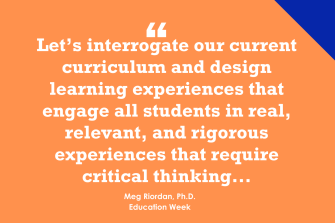
Critical Thinking & Student Engagement
Dr. PJ Caposey is an award-winning educator, keynote speaker, consultant, and author of seven books who currently serves as the superintendent of schools for the award-winning Meridian CUSD 223 in northwest Illinois. You can find PJ on most social-media platforms as MCUSDSupe:
When I start my keynote on student engagement, I invite two people up on stage and give them each five paper balls to shoot at a garbage can also conveniently placed on stage. Contestant One shoots their shot, and the audience gives approval. Four out of 5 is a heckuva score. Then just before Contestant Two shoots, I blindfold them and start moving the garbage can back and forth. I usually try to ensure that they can at least make one of their shots. Nobody is successful in this unfair environment.
I thank them and send them back to their seats and then explain that this little activity was akin to student engagement. While we all know we want student engagement, we are shooting at different targets. More importantly, for teachers, it is near impossible for them to hit a target that is moving and that they cannot see.
Within the world of education and particularly as educational leaders, we have failed to simplify what student engagement looks like, and it is impossible to define or articulate what student engagement looks like if we cannot clearly articulate what critical thinking is and looks like in a classroom. Because, simply, without critical thought, there is no engagement.
The good news here is that critical thought has been defined and placed into taxonomies for decades already. This is not something new and not something that needs to be redefined. I am a Bloom’s person, but there is nothing wrong with DOK or some of the other taxonomies, either. To be precise, I am a huge fan of Daggett’s Rigor and Relevance Framework. I have used that as a core element of my practice for years, and it has shaped who I am as an instructional leader.
So, in order to explain critical thought, a teacher or a leader must familiarize themselves with these tried and true taxonomies. Easy, right? Yes, sort of. The issue is not understanding what critical thought is; it is the ability to integrate it into the classrooms. In order to do so, there are a four key steps every educator must take.
- Integrating critical thought/rigor into a lesson does not happen by chance, it happens by design. Planning for critical thought and engagement is much different from planning for a traditional lesson. In order to plan for kids to think critically, you have to provide a base of knowledge and excellent prompts to allow them to explore their own thinking in order to analyze, evaluate, or synthesize information.
- SIDE NOTE – Bloom’s verbs are a great way to start when writing objectives, but true planning will take you deeper than this.
QUESTIONING
- If the questions and prompts given in a classroom have correct answers or if the teacher ends up answering their own questions, the lesson will lack critical thought and rigor.
- Script five questions forcing higher-order thought prior to every lesson. Experienced teachers may not feel they need this, but it helps to create an effective habit.
- If lessons are rigorous and assessments are not, students will do well on their assessments, and that may not be an accurate representation of the knowledge and skills they have mastered. If lessons are easy and assessments are rigorous, the exact opposite will happen. When deciding to increase critical thought, it must happen in all three phases of the game: planning, instruction, and assessment.
TALK TIME / CONTROL
- To increase rigor, the teacher must DO LESS. This feels counterintuitive but is accurate. Rigorous lessons involving tons of critical thought must allow for students to work on their own, collaborate with peers, and connect their ideas. This cannot happen in a silent room except for the teacher talking. In order to increase rigor, decrease talk time and become comfortable with less control. Asking questions and giving prompts that lead to no true correct answer also means less control. This is a tough ask for some teachers. Explained differently, if you assign one assignment and get 30 very similar products, you have most likely assigned a low-rigor recipe. If you assign one assignment and get multiple varied products, then the students have had a chance to think deeply, and you have successfully integrated critical thought into your classroom.

Thanks to Dara, Patrick, Meg, and PJ for their contributions!
Please feel free to leave a comment with your reactions to the topic or directly to anything that has been said in this post.
Consider contributing a question to be answered in a future post. You can send one to me at [email protected] . When you send it in, let me know if I can use your real name if it’s selected or if you’d prefer remaining anonymous and have a pseudonym in mind.
You can also contact me on Twitter at @Larryferlazzo .
Education Week has published a collection of posts from this blog, along with new material, in an e-book form. It’s titled Classroom Management Q&As: Expert Strategies for Teaching .
Just a reminder; you can subscribe and receive updates from this blog via email (The RSS feed for this blog, and for all Ed Week articles, has been changed by the new redesign—new ones won’t be available until February). And if you missed any of the highlights from the first nine years of this blog, you can see a categorized list below.
- This Year’s Most Popular Q&A Posts
- Race & Racism in Schools
- School Closures & the Coronavirus Crisis
- Classroom-Management Advice
- Best Ways to Begin the School Year
- Best Ways to End the School Year
- Student Motivation & Social-Emotional Learning
- Implementing the Common Core
- Facing Gender Challenges in Education
- Teaching Social Studies
- Cooperative & Collaborative Learning
- Using Tech in the Classroom
- Student Voices
- Parent Engagement in Schools
- Teaching English-Language Learners
- Reading Instruction
- Writing Instruction
- Education Policy Issues
- Differentiating Instruction
- Math Instruction
- Science Instruction
- Advice for New Teachers
- Author Interviews
- Entering the Teaching Profession
- The Inclusive Classroom
- Learning & the Brain
- Administrator Leadership
- Teacher Leadership
- Relationships in Schools
- Professional Development
- Instructional Strategies
- Best of Classroom Q&A
- Professional Collaboration
- Classroom Organization
- Mistakes in Education
- Project-Based Learning
I am also creating a Twitter list including all contributors to this column .
The opinions expressed in Classroom Q&A With Larry Ferlazzo are strictly those of the author(s) and do not reflect the opinions or endorsement of Editorial Projects in Education, or any of its publications.
Sign Up for EdWeek Update
Edweek top school jobs.

Sign Up & Sign In

